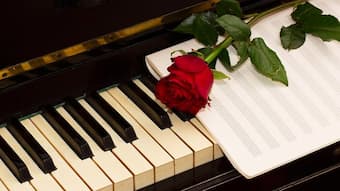
© Classic FM
A famous writer once said, “Music is the most romantic of all arts.” And then he goes on to say that it “unlocks an unknown realm, a word with nothing in common with the surrounding outer worlds of the senses. Listening to music we abandon definite feelings and surrender to an inexpressible longing.”
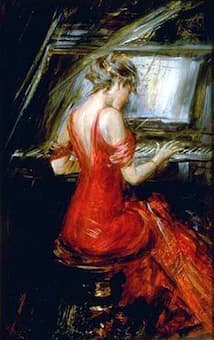
Giovanni Boldini: The Woman in Red
I am sure you know what he is talking about, because at one time or another, we have all been captured by a song or a piece of music we heard on the radio or at a concert. And do you remember that moment when a song had such a deep impact that it filled you with strong and almost overpowering emotions ranging from joy to sadness? Today we know that music deeply affect the emotional centers in the brain, and while “a single tone is not really pleasurable in itself, once it is organized over time in some sort of arrangement, it becomes amazingly powerful.” The emotions we felt years ago while listening to a special song will never go away, and we will remember it forever. And that is particularly true if you listen to music with that special person in your life.
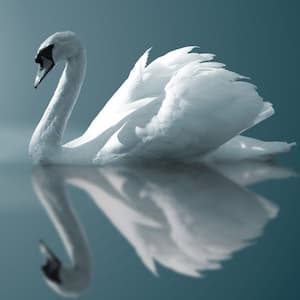
The Swan
The world and circumstances might change over time, but you will always remember that powerful feeling of having a deep emotional connection with another person. Hey, that’s why music is the language of love! Of course it’s all very subjective, but we have nevertheless compiled a list of romantic classical music that will have a definite affect on your emotions. Let’s get started with the best of classical music by listening to “The Swan,” from Camille Saint-Saëns Carnival of the Animals.
Camille Saint-Saëns: The Carnival of the Animals (The Swan)
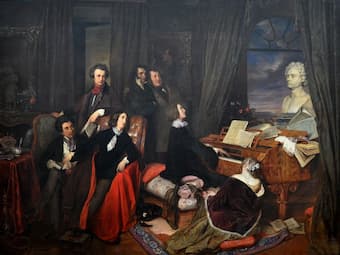
Franz Liszt at the piano
Don’t you just love the way the cello is able to sing such a sweet and powerful melody? However, the most romantic instrument has long been the piano. The late 18th century forte-piano became the rage with professional pianists, but amateurs from the aristocracy and the middle class also played it. By the first half of the 19th century the instrument had undergone substantial technical changes. And the foremost musical personalities and arguable the greatest virtuoso of his day took full advantage of these changes. His name was Franz Liszt and he was part of a social phenomenon inspired by his personality and his playing. Believe it or not, audiences went absolutely hysterical looking at this first modern superstar of the stage. A contemporary observer wrote, “women simply threw themselves at him…Tall and handsome from any angle with Hungarian paprika pulsing through his veins, and simultaneously capable of transforming the piano into an altar—predominantly to worship himself—this highly observant and intelligent man exuded a magnetism that was partly based on personality cult, and also on a deeply spiritual inclination.” His “Dream of Love” is a great example of romantic classical music, and it represents the best of classical music.
Franz Liszt: Liebestraum

Beethoven playing for Mozart
Ludwig van Beethoven wasn’t particularly lucky in love. He always seemed to fall in love with the wrong woman. He often fell in love with his much-younger students, or with women that were already happily married or engaged to somebody else. Most of the time, Beethoven felt affections for women of a much higher social standing. There was absolutely no chance that he would ever succeed. A scholar once wrote, “Thus Beethoven was usually doomed to get nowhere in his relationships—as perhaps, unconsciously, he intended.” The theme of unattainable love becomes an important theme in many of his compositions. In his best music Beethoven was yearning for the infinite, searching for tranquility and freedom. Such is the case in the two romances he wrote for violin. In the beautifully smooth and flowing and singing lines we can hear the melancholy of lost love and simultaneously a philosophical and poetic contemplation. This is romantic classical music at its best.
Ludwig van Beethoven: Romance
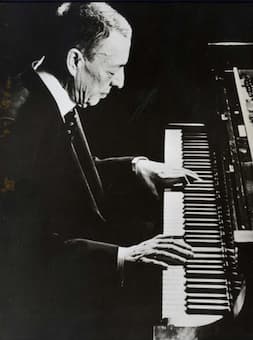
Sergei Rachmaninoff
Sergei Rachmaninoff is one of my favourite composers. For one, his music is full of melancholy expressiveness packaged in tremendous pianistic virtuosity. As a composer, he always carries his feelings on his sleeve, and these intense feelings are always allowed to surface in his music. Rachmaninoff freely admitted that his emotional states are reflected in his work. “I write that which is in my heart at the time I am composing…these moods become part of my music.” His 2nd piano concerto made Rachmaninoff famous, and he filled it with emotional unforgettable tunes and rhapsodic emotions. The music unfolds effortlessly, and the composer once wrote, “Melody is music and the foundation of all music. I do not appreciate composers who abandon melody and harmony for an orgy of noises and dissonances.” Every singly movement is incredible romantic classical music, but for me, the sensual beauty of the “Adagio” creates a unique atmosphere of enchanted otherworldliness.
Sergei Rachmaninoff: Piano Concerto No. 2, “Adagio sostenuto”

Francois Boucher: Allegory of Music
Here is a little quiz question for you. Do you know the name of the first ever-recorded work by Johann Sebastian Bach? I know there are many choices, but it turns out to have been the “Air on the G string” from his 3rd orchestral suite. The cellist Aleksandr Verzhbilovich made that recording in 1902. The famous nickname of the piece does not come from Bach himself, but it was attached by the violinist August Wilhelmj almost a century and a half after Bach’s death. Wilhelmj made an arrangement for solo violin and strings (or keyboard), and while transposing the piece down to C major, he marked the solo part “on the G-string.” The name stuck and it certainly is one of the most passionately expressive tour-de-force that Bach ever wrote. It is one of Bach’s most magnificent creations, and it has been arranged for an infinite variety of instruments and ensembles. That little piece has always deeply moved listeners around the world, and it is always represented on lists of the best of classical music.
Johann Sebastian Bach: Orchestral Suite No. 3 “Air on the G String”

The Mozart family
At the beginning of the 18th century the German instrument builder Johann Christoph Denner experimented with a single-reed instrument called the “Chalumeau.” It looked like a recorder but was terribly difficult to play because the tone-hole position for the lower register was different from that of the upper. Denner finally was able to build a new instrument by adding two additional holes in the lower register. In time keys were added and by around 1750 the five-key clarinet had become the standard. Wolfgang Amadeus Mozart was inspired by the clarinetist Anton Stadler to write several pieces for the clarinet. Critics heard Stadler in performance and commented, “I would not have thought that a clarinet could imitate the human voice so deceptively.” The Clarinet Concerto was Mozart’s final instrumental work and it represents the composer at the height of his creative powers. In his review of the premier performance, the music critic Bernhard Weber wrote, “Such an abundance of beauty almost tires the soul.” It is simultaneously enchanting and beguiling and represents some of the best romantic classical music ever composed.
Wolfgang Amadeus Mozart: Clarinet Concerto “Adagio”

Chopin in the salon concert
Frédéric Chopin was one of the greatest pianists the world has ever known. He did not write symphonies, operas or choral works, but almost exclusively composed music for the piano. “In my music,” he once remarked, “one can divine the restlessness of the artist.” The famous playwright Oscar Wilde wrote, “After playing Chopin, I feel as if I had been weeping over sins that I had never committed, and mourning over tragedies that were not my own.” For Wilde “music creates a past of which one has been ignorant, and fills one with a sense of sorrows that had been hidden from one’s tears.” When we talk about romantic longing, we certainly find plenty of it in Chopin’s music. He is often called the “poet of the piano,” and his romantic intensity translated beautifully into music. Chopin’s status as one of music’s earliest celebrities, his indirect association with political insurrection, his high-profile love life, and his early death has made him a leading symbol of the Romantic era.
Frédéric Chopin: Nocturne, Op. 32, No. 2
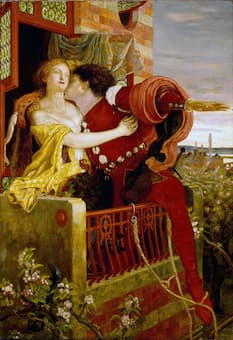
Ford Madox Brown: Romeo and Juliet
Pyotr Ilyich Tchaikovsky thought of himself as a musical dramatist and was always looking for suitable opera subjects. Shakespeare was an obvious choice, and the composer was inexorably drawn to Romeo and Juliet, the most famous lovers of all time. “Nothing is more suitable to my musical character,” he writes, “No kings, no marches, no boring old grand opera. Just love, love, love!” Regrettably, nothing ever came of his grand theatrical dreams, but at the beginning stages of his career he did compose his delightful Romeo and Juliet Overture-Fantasy. The famous love theme, which enters after the noisy and action-paced street music, is one of Tchaikovsky’s most unforgettable melodies. Romantic classical music does not get any better!
Pyotr Ilyich Tchaikovsky: Romeo & Juliet
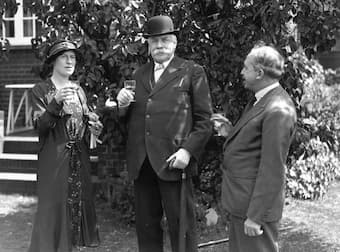
Edward Elgar and Caroline Alice Roberts
I want to conclude this little collection of romantic classical music with one of my all-time favourite pieces. Edward Elgar was always drawn to older, intelligent and highly talented women. And Caroline Alice Roberts, who was an exceptional pianist and fluently spoke a number of languages, immediately caught his eyes. He was eight years younger, a devout Roman Catholic and came from a significantly lower social class. She was a protestant, and born in India into a highly distinguished family. But when he gave her music lessons, the sparks started to fly. Against the wishes of parents and relatives they announced their engagement, and Elgar presented his bride to be with a “Love’s Greeting.” Salut d’Amour became one of Elgar’s best-known compositions and a staple of romantic classical music. Now you know my favourites, what are yours?
For more of the best in classical music, sign up to our E-Newsletter
Edward Elgar: Salut d’Amour



Why is there no guitar piece here?